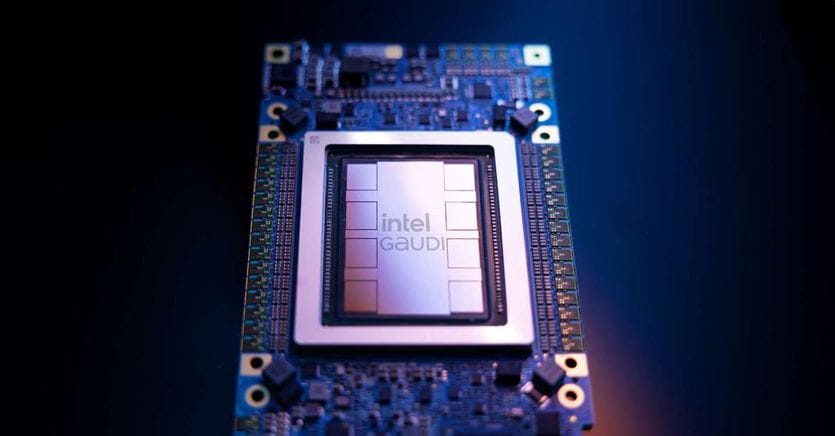Listen to the audio version of the article
Bringing performance, open standards, scalable systems and broad possibilities of choice to apply generative artificial intelligence in enterprise-class processes: this is in fact the mantra of almost all technology companies that want to get on the Gen AI train aimed at the world of companies and Intel has also made it its own, more than ever called upon to provide substantial responses to Nividia’s continuous announcements. The challenge for supremacy in chips destined to process the data ground by algorithms and to train large format language models has come to life and the Santa Clara company took the opportunity of the Vision 2024 event, held in recent days in Phoenix, Arizona, to strike a new blow in his turn. The scenario in which the company’s top management positioned and described the main product innovation, the Gaudi 3 AI accelerator, is the following: in 2023, as stated in research conducted by cnvrg.io, an Intel subsidiary specialized in the field of LLM models, only 10% of global enterprises have successfully brought generative AI projects into production. There is therefore room to enter a market that has enormous development potential and the path that Intel has decided to follow, as CEO Pat Gelsinger also recalled in his speech, is precisely that of bringing artificial intelligence in every part of the enterprise, from personal computers to the data center to the edge, helping companies move from the pilot phase of Gen AI projects to production.
The challenge (you learn) to Nvidia
The objective, undeclared but evident, is to take away market shares from those who today are the undisputed masters of silicon technologies in the enterprise sector, namely Nvidia, which according to various estimates currently captures over 80% of AI chip sales thanks to its high-end GPUs adopted by large cloud providers and manufacturers of hardware infrastructure (servers and super computers) for artificial intelligence. The key point of the question, according to various analysts, is how much the rivals of the Californian giant – Intel and AMD (whose MI300X graphics unit for data centers launched last year counts Meta and Microsoft among its customers) – can fit into this game by leverage on proposals with cheaper costs and performances not too far from those promised by the new Nvidia B100 and B200 GPUs, arriving at the end of the year. The challenge, it should be noted, is not played (only) on the pure performance front, but in an ecosystem logic. If Nvidia has built its fortunes in the field of semiconductors for AI by providing those who work with artificial intelligence with a powerful suite of proprietary software (called CUDA) that facilitates access to all the hardware features of a GPU, Intel is collaborating with several giants of the tech industry – the names are Google, Qualcomm and Arm – to build open platforms that leave total flexibility to software companies in choosing the most suitable chip architecture for their needs.
The new AI chip and the plus in energy consumption
Two, among many, are the peculiarities that distinguish the new Gaudi 3 AI accelerator. The first, as stated in a note, is linked to the fact that the 5 nanometer chip in question will power AI systems with a potential of tens of thousands of accelerators connected via Ethernet technology, promising four times more computing power for BFloat16 (floating-point number format that occupies 16 bits in computer memory) and one and a half times more memory bandwidth than its predecessor . A significant leap forward, therefore, in the ability to train the LLM models (the product has been tested on Meta’s Llama and the open source Falcon and is ready to operate with OpenAI’s Stable Diffusion or Whisper for speech recognition) necessary for implement large-scale generative artificial intelligence applications. The other plus that Gaudi 3 is credited with is the energy efficiency, more than double according to what Intel managers say, of Nvidia’s H100 GPU. And not only. Compared to the competing chip, the new accelerator promises an average 50% faster “time to train” in the execution of AI processes (the data refers to the Llama2 models with 7B and 13B parameters and the GPT-3 model with 175B parameters ) and an average of 50% higher inference throughput in performance and 40% higher in efficiency (for the Llama 7B and 70B parameters and the Falcon 180B parameters). Finally, a final declared advantage of Gaudi 3 is the fact that it provides open software and standard Ethernet networks, so as to make it easier for companies to scale flexibly from a single node to cluster and super-cluster configurations. and mega-clusters with thousands of nodes. Its availability for OEM manufacturers, including Dell Technologies, Hewlett Packard Enterprise and Lenovo, and for partners (including tech giants such as IBM and Bosch, one of the main Asian data center providers such as the Indian CtrlS and computer specialists vision such as Landing AI and Roboflow) is set for the end of this second quarter. Intel believes in it, convinced that it is “a strong offer” and that the game to win in the AI chip business has just begun. And the move to open a new factory in Ohio between 2027 and 2028 to produce artificial intelligence processors also intended for external companies undoubtedly confirms this vision.
